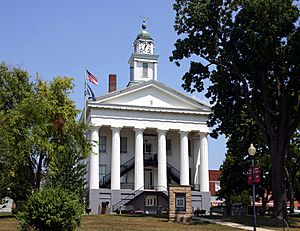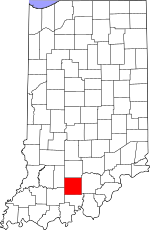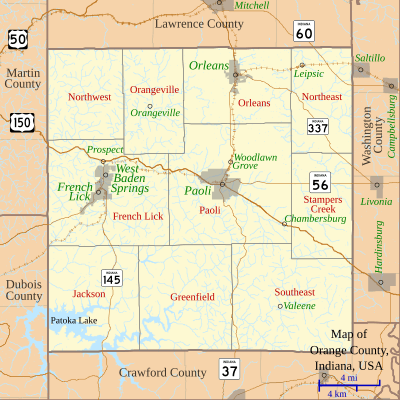Orange County, Indiana facts for kids
Quick facts for kids
Orange County
|
|
|---|---|

The Orange County courthouse in Paoli
|
|

Location within the U.S. state of Indiana
|
|
 Indiana's location within the U.S. |
|
| Country | |
| State | |
| Founded | February 1, 1816 |
| Named for | House of Orange-Nassau |
| Seat | Paoli |
| Largest town | Paoli |
| Area | |
| • Total | 408.19 sq mi (1,057.2 km2) |
| • Land | 398.39 sq mi (1,031.8 km2) |
| • Water | 9.80 sq mi (25.4 km2) 2.40%% |
| Population | |
| • Estimate
(2018)
|
19,489 |
| • Density | 49.7/sq mi (19.17/km2) |
| Time zone | UTC−5 (Eastern) |
| • Summer (DST) | UTC−4 (EDT) |
| Congressional district | 9th |
| Indiana county number 59 | |
Orange County is located in southern Indiana in the United States. As of 2010, its population was 19,840, an increase of 2.8% from 19,306 in 2000. The county seat is Paoli. The county has four incorporated settlements with a total population of about 8,600, as well as several small unincorporated communities. It is divided into 10 townships which provide local services. One U.S. route and five Indiana state roads pass through or into the county.
Contents
History
Orange County was formed from parts of Knox County, Gibson County and Washington County by an act approved on December 26, 1815; it took effect on February 1, 1816. The same year, the county seat was established in Paoli, which was named after Pasquale Paoli Ash, the 12-year-old son of the Governor, at the time, of North Carolina .
The first courthouse was a temporary log structure that was built for $25; a more permanent structure of stone was completed in 1819 at a cost of $3,950. In 1847, plans were made for a new larger courthouse, which was completed in 1850 at a cost of $14,000. This building is the second oldest courthouse in the state that has been continuously used since its construction. Like the oldest in Ohio County, it is a Greek Revival building with two stories and a Doric portico supported by fluted columns; it has ornamental iron stairs and a clock tower. In 1970, the clock tower was damaged by fire.
The early settlers were mostly Quakers fleeing the institution of slavery in Orange County, North Carolina. Jonathan Lindley brought his group of Quakers from North Carolina to the area in 1811. Under Lindley's leadership, they were the first to build a religious structure, the Lick Creek Meeting House in 1813. It was from this group that Orange County got its name. (See List of Indiana county name etymologies). The name Orange derives from the Dutch Protestant House of Orange, which acquired the English throne with the accession of King William III in 1689, following the Glorious Revolution.
In the early 19th century when the Quakers came from North Carolina to settle in Orange County, Indiana, they came to escape slavery. They brought with them a number of freed slaves. These free men were deeded 200 acres (0.81 km2) of land in the heart of a dense forest. Word of mouth soon spread the news, and this land became part of the "underground railroad" for runaway slaves.
For many years, the freed slaves in this area farmed, traded, and sold their labor to others while living in this settlement. A church was built and a cemetery was provided for their loved ones.
All that remains today is the cemetery. Some of the stones were broken or vandalized over the years. Several years ago, a troop of Boy Scouts came in and restored the cemetery, replacing the lost or broken stones with wooden crosses designating a grave. The name of "Little Africa" came about because of the black settlement, but "Paddy's Garden" was the name those early residents called it.
Geography
Orange County is located in the south part of the state. It is bordered by Lawrence County to the north; Martin and Dubois counties to the west; Crawford County to the south; and Washington County to the east. According to the 2010 census, the county has a total area of 408.19 square miles (1,057.2 km2), of which 398.39 square miles (1,031.8 km2) (or 97.60%) is land and 9.80 square miles (25.4 km2) (or 2.40%) is water.
Orange County contains four incorporated settlements. The largest is the county seat of Paoli, which lies near the center of the county. To the north of Paoli lies Orleans. To the west, French Lick and West Baden Springs are connected but are separate entities.
There are several small unincorporated settlements in the county. Chambersburg lies along U.S. Route 150 about 4 miles (6.4 km) southeast of Paoli. To the east of Orleans in the northeast corner of the county is the town of Leipsic. Prospect is on U.S. Route 150 just north of West Baden Springs. Orangeville is northwest of Paoli, near the center of Orangeville Township. In the southeast corner of the county, Valeene lies near the center of Southeast Township.
Much of the south part of the county, south of Paoli and French Lick, is part of the Hoosier National Forest. Patoka Lake is within the national forest; the majority of the lake lies in Orange County, with parts extending into neighboring Dubois and Crawford counties.
The county is divided into 10 townships:
- French Lick
- Greenfield
- Jackson
- Northeast
- Northwest
- Orangeville
- Orleans
- Paoli
- Southeast
- Stampers Creek
Transportation
Highways
- U.S. Route 150 – runs east–west through central part of county. Passes French Lick, Turleys, and Paoli.
 Indiana State Road 37 – runs north–south through central part of county. Passes Orleans, Paoli, and Bacon.
Indiana State Road 37 – runs north–south through central part of county. Passes Orleans, Paoli, and Bacon. Indiana State Road 56 – enters west line of county at 6.6 miles (10.6 km) north of SW county corner. Runs NE to intersection with US-150 north of West Baden Springs.
Indiana State Road 56 – enters west line of county at 6.6 miles (10.6 km) north of SW county corner. Runs NE to intersection with US-150 north of West Baden Springs. Indiana State Road 60 – runs NW-SE across northeastern tip of county. Enters 2 miles west of NE corner and exits 2 miles south of NE corner.
Indiana State Road 60 – runs NW-SE across northeastern tip of county. Enters 2 miles west of NE corner and exits 2 miles south of NE corner. Indiana State Road 145 – enters south line of county at 3.7 miles (6 km) from SW county corner. Runs north to intersection with Indiana-56 at French Lick.
Indiana State Road 145 – enters south line of county at 3.7 miles (6 km) from SW county corner. Runs north to intersection with Indiana-56 at French Lick. Indiana State Road 337 – runs SE-NW across northeastern part of county. Enters east line of county near Bromer, then runs NW to intersection with Indiana-37 at Orleans.
Indiana State Road 337 – runs SE-NW across northeastern part of county. Enters east line of county near Bromer, then runs NW to intersection with Indiana-37 at Orleans.
Airports
- Paoli Municipal Airport - public-owned public-use general-aviation airport with one paved runway.
- French Lick Municipal Airport
French Lick Municipal Airport (IATA: FRH, ICAO: KFRH, FAA LID: FRH) is a city-owned public-use airport located three nautical miles (6 km) southwest of the central business district of French Lick, a town in Orange County, Indiana, United States.[1] Also known as French Lick Airport, it serves the French Lick and West Baden, Indiana area.[2]
Railways
French Lick Scenic Railway (French Lick West Baden and Southern Railway/ Indiana Railway Museum) Popular train rides in Indiana aboard the French Lick Scenic Railway offer 20-mile day tours through parts of the Hoosier National Forest, the 2,200-foot Burton Tunnel (Indiana's second longest tunnel), and past limestone outcroppings.
Check the daily departure schedule but know the historic French Lick Scenic Railway also hosts special events and seasonal trips throughout the year, like these famous family attractions:
Wild-West Hold-ups Tasting Trains Easter Bunny Express Dinner Trains
Climate and weather
| Weather chart for Paoli, Indiana | |||||||||||||||||||||||||||||||||||||||||||||||
|---|---|---|---|---|---|---|---|---|---|---|---|---|---|---|---|---|---|---|---|---|---|---|---|---|---|---|---|---|---|---|---|---|---|---|---|---|---|---|---|---|---|---|---|---|---|---|---|
| J | F | M | A | M | J | J | A | S | O | N | D | ||||||||||||||||||||||||||||||||||||
|
3.3
38
18
|
3.1
44
22
|
4.4
55
31
|
4.8
65
40
|
5.1
75
50
|
4.2
83
60
|
4.5
87
64
|
4.2
85
62
|
3.3
79
53
|
2.9
68
40
|
4.2
55
32
|
3.6
43
23
|
||||||||||||||||||||||||||||||||||||
| temperatures in °F precipitation totals in inches source: The Weather Channel |
|||||||||||||||||||||||||||||||||||||||||||||||
|
Metric conversion
|
|||||||||||||||||||||||||||||||||||||||||||||||
In recent years, average temperatures in Paoli have ranged from a low of 18 °F (−8 °C) in January to a high of 87 °F (31 °C) in July, although a record low of −29 °F (−34 °C) was recorded in January 1994 and a record high of 111 °F (44 °C) was recorded in July 1901. Average monthly precipitation ranged from 2.90 inches (74 mm) in October to 5.14 inches (131 mm) in May.
Demographics
| Historical population | |||
|---|---|---|---|
| Census | Pop. | %± | |
| 1820 | 5,368 | — | |
| 1830 | 7,901 | 47.2% | |
| 1840 | 9,602 | 21.5% | |
| 1850 | 10,809 | 12.6% | |
| 1860 | 12,076 | 11.7% | |
| 1870 | 13,497 | 11.8% | |
| 1880 | 14,363 | 6.4% | |
| 1890 | 14,678 | 2.2% | |
| 1900 | 16,854 | 14.8% | |
| 1910 | 17,192 | 2.0% | |
| 1920 | 16,974 | −1.3% | |
| 1930 | 17,459 | 2.9% | |
| 1940 | 17,311 | −0.8% | |
| 1950 | 16,879 | −2.5% | |
| 1960 | 16,877 | 0.0% | |
| 1970 | 16,968 | 0.5% | |
| 1980 | 18,677 | 10.1% | |
| 1990 | 18,409 | −1.4% | |
| 2000 | 19,306 | 4.9% | |
| 2010 | 19,840 | 2.8% | |
| 2018 (est.) | 19,489 | −1.8% | |
| US Decennial Census 1790-1960 1900-1990 1990-2000 2010-2013 |
|||
As of the 2010 United States Census, there were 19,840 people, 7,872 households, and 5,416 families in the county. The population density was 49.8 inhabitants per square mile (19.2/km2). There were 9,176 housing units at an average density of 23.0 per square mile (8.9/km2). The racial makeup of the county was 97.0% white, 0.9% black or African American, 0.3% Asian, 0.3% American Indian, 0.3% from other races, and 1.2% from two or more races. Those of Hispanic or Latino origin made up 1.0% of the population. In terms of ancestry, 22.6% were of English ancestry, 18.8% were of German ancestry and 12.4% were of Irish ancestry.
Of the 7,872 households, 32.3% had children under the age of 18 living with them, 53.4% were married couples living together, 10.4% had a female householder with no husband present, 31.2% were non-families, and 26.7% of all households were made up of individuals. The average household size was 2.49 and the average family size was 3.00. The median age was 40.8 years.
The median income for a household in the county was $47,697 and the median income for a family was $45,874. Males had a median income of $35,679 versus $30,072 for females. The per capita income for the county was $19,119. About 13.5% of families and 20.2% of the population were below the poverty line, including 29.7% of those under age 18 and 14.7% of those age 65 or over.
Education
The county is served by four school districts:
- Lost River Career Cooperative
- Orleans Community Schools
- Paoli Community School Corporation
- Springs Valley Community School Corporation.
Orleans Community Schools (Superintendent:Gary McClintic) includes:
- Orleans Elementary School (Principal: Christopher Stevens)
- Orleans Jr./Sr. High School (Principal: Roy Kline).
Paoli Community Schools (Superintendent:Greg Walker)includes:
- Throop Elementary School (Principal:Amanda Crews)
- Paoli Jr./Sr. High School (Principal:Dr. Sherry Wise).
Springs Valley School Corporation (Superintendent: Tony Whitaker) includes:
- Springs Valley Elementary School (Principal:Trevor Apple)
- Springs Valley Jr./Sr. High School (Principal: Kyle Neukam)
See also
 In Spanish: Condado de Orange (Indiana) para niños
In Spanish: Condado de Orange (Indiana) para niños




